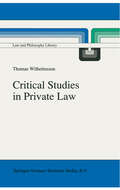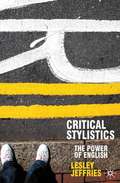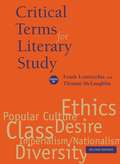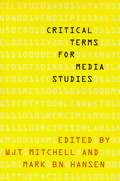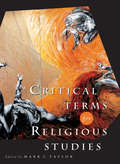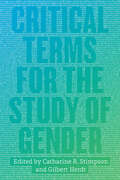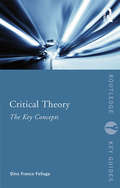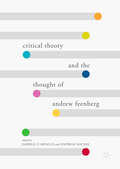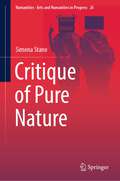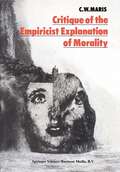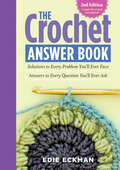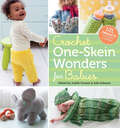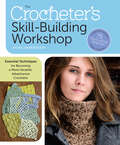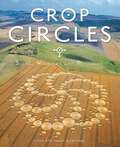- Table View
- List View
Critical Studies in Private Law: A Treatise on Need-Rational Principles in Modern Law (Law and Philosophy Library #16)
by T. WilhelmssonCritical Studies in Private Law discusses the prerequisites and possibilities for an alternative or critical legal dogmatics. The starting point of the analysis is the recognition of contradictions within the legal order. In this respect the theory may use the experience of both American Critical Legal Studies and the German attempts to formulate a legal theory for the social state. The key for understanding how the contradictory concrete legal material may produce varying results on the level of legal decisions is the systematization, the general principles of the law. The analysis does not, however, stop at this theoretical level. The methodology is tested through a discussion of some features of modern private law. Some key elements of contract law, including consumer law, of the Welfare State are singled out. The work focuses on the person-orientation of modern law as a challenge to the traditional abstract legal form. The aim is to explore the limits for a contract law radically oriented towards the personal social and economic needs of the parties. This endeavour involves the creation of new legal concepts such as social force majeure.
Critical Stylistics: The Power Of English (PDF)
by Lesley JeffriesWe tend to think that politicians, copywriters and journalists can affect us by their use of language, but how does this happen, exactly? Critical Discourse Analysis provides us with general theories for explaining the impact texts can have, considering the social and political contexts in which texts are produced and read. Stylistics provides detailed tools of analysis for understanding how texts work. Critical Stylistics combines the strengths of these two approaches to uncover the deep-seated ideologies of everyday texts. Original and engaging,Critical Stylistics: * presents a new amalgamation of stylistics, critical discourse analysis and functional approaches to grammar * introduces a comprehensive set of tools to help explain and analyse the power of written texts * examines a wide variety of real texts and provides a wealth of practical worked examples
Critical Terms for Literary Study, Second Edition (Critical Terms)
by Lentricchia, Frank and McLaughlin, ThomasSince its publication in 1990, Critical Terms for Literary Study has become a landmark introduction to the work of literary theory—giving tens of thousands of students an unparalleled encounter with what it means to do theory and criticism. Significantly expanded, this new edition features six new chapters that confront, in different ways, the growing understanding of literary works as cultural practices. These six new chapters are "Popular Culture," "Diversity," "Imperialism/Nationalism," "Desire," "Ethics," and "Class," by John Fiske, Louis Menand, Seamus Deane, Judith Butler, Geoffrey Galt Harpham, and Daniel T. O'Hara, respectively. Each new essay adopts the approach that has won this book such widespread acclaim: each provides a concise history of a literary term, critically explores the issues and questions the term raises, and then puts theory into practice by showing the reading strategies the term permits. Exploring the concepts that shape the way we read, the essays combine to provide an extraordinary introduction to the work of literature and literary study, as the nation's most distinguished scholars put the tools of critical practice vividly to use.
Critical Terms for Media Studies (Critical Terms)
by W. J. T. Mitchell Mark B. N. HansenCommunications, philosophy, film and video, digital culture: media studies straddles an astounding array of fields and disciplines and produces a vocabulary that is in equal parts rigorous and intuitive. Critical Terms for Media Studies defines, and at times, redefines, what this new and hybrid area aims to do, illuminating the key concepts behind its liveliest debates and most dynamic topics. Part of a larger conversation that engages culture, technology, and politics, this exciting collection of essays explores our most critical language for dealing with the qualities and modes of contemporary media. Edited by two outstanding scholars in the field, W. J. T. Mitchell and Mark B. N. Hansen, the volume features works by a team of distinguished contributors. These essays, commissioned expressly for this volume, are organized into three interrelated groups: “Aesthetics” engages with terms that describe sensory experiences and judgments, “Technology” offers entry into a broad array of technological concepts, and “Society” opens up language describing the systems that allow a medium to function. A compelling reference work for the twenty-first century and the media that form our experience within it, Critical Terms for Media Studies will engage and deepen any reader’s knowledge of one of our most important new fields.
Critical Terms for Media Studies (Critical Terms)
by W. J. T. Mitchell Mark B. N. HansenCommunications, philosophy, film and video, digital culture: media studies straddles an astounding array of fields and disciplines and produces a vocabulary that is in equal parts rigorous and intuitive. Critical Terms for Media Studies defines, and at times, redefines, what this new and hybrid area aims to do, illuminating the key concepts behind its liveliest debates and most dynamic topics. Part of a larger conversation that engages culture, technology, and politics, this exciting collection of essays explores our most critical language for dealing with the qualities and modes of contemporary media. Edited by two outstanding scholars in the field, W. J. T. Mitchell and Mark B. N. Hansen, the volume features works by a team of distinguished contributors. These essays, commissioned expressly for this volume, are organized into three interrelated groups: “Aesthetics” engages with terms that describe sensory experiences and judgments, “Technology” offers entry into a broad array of technological concepts, and “Society” opens up language describing the systems that allow a medium to function. A compelling reference work for the twenty-first century and the media that form our experience within it, Critical Terms for Media Studies will engage and deepen any reader’s knowledge of one of our most important new fields.
Critical Terms for Media Studies (Critical Terms)
by W. J. T. Mitchell Mark B. N. HansenCommunications, philosophy, film and video, digital culture: media studies straddles an astounding array of fields and disciplines and produces a vocabulary that is in equal parts rigorous and intuitive. Critical Terms for Media Studies defines, and at times, redefines, what this new and hybrid area aims to do, illuminating the key concepts behind its liveliest debates and most dynamic topics. Part of a larger conversation that engages culture, technology, and politics, this exciting collection of essays explores our most critical language for dealing with the qualities and modes of contemporary media. Edited by two outstanding scholars in the field, W. J. T. Mitchell and Mark B. N. Hansen, the volume features works by a team of distinguished contributors. These essays, commissioned expressly for this volume, are organized into three interrelated groups: “Aesthetics” engages with terms that describe sensory experiences and judgments, “Technology” offers entry into a broad array of technological concepts, and “Society” opens up language describing the systems that allow a medium to function. A compelling reference work for the twenty-first century and the media that form our experience within it, Critical Terms for Media Studies will engage and deepen any reader’s knowledge of one of our most important new fields.
Critical Terms for Religious Studies (Critical Terms)
by Mark C. TaylorA century that began with modernism sweeping across Europe is ending with a remarkable resurgence of religious beliefs and practices throughout the world. Wherever one looks today, from headlines about political turmoil in the Middle East to pop music and videos, one cannot escape the pivotal role of religious beliefs and practices in shaping selves, societies, and cultures. Following in the very successful tradition of Critical Terms for Literary Studies and Critical Terms for Art History, this book attempts to provide a revitalized, self-aware vocabulary with which this bewildering religious diversity can be accurately described and responsibly discussed. Leading scholars working in a variety of traditions demonstrate through their incisive discussions that even our most basic terms for understanding religion are not neutral but carry specific historical and conceptual freight. These essays adopt the approach that has won this book's predecessors such widespread acclaim: each provides a concise history of a critical term, explores the issues raised by the term, and puts the term to use in an analysis of a religious work, practice, or event. Moving across Judaism, Christianity, Hinduism, Buddhism, Islam, and Native American and Mayan religions, contributors explore terms ranging from experience, territory, and image, to God, sacrifice, and transgression. The result is an essential reference that will reshape the field of religious studies and transform the way in which religion is understood by scholars from all disciplines, including anthropology, sociology, psychology, cultural studies, gender studies, and literary studies.
Critical Terms for Religious Studies (Critical Terms)
by Mark C. TaylorA century that began with modernism sweeping across Europe is ending with a remarkable resurgence of religious beliefs and practices throughout the world. Wherever one looks today, from headlines about political turmoil in the Middle East to pop music and videos, one cannot escape the pivotal role of religious beliefs and practices in shaping selves, societies, and cultures. Following in the very successful tradition of Critical Terms for Literary Studies and Critical Terms for Art History, this book attempts to provide a revitalized, self-aware vocabulary with which this bewildering religious diversity can be accurately described and responsibly discussed. Leading scholars working in a variety of traditions demonstrate through their incisive discussions that even our most basic terms for understanding religion are not neutral but carry specific historical and conceptual freight. These essays adopt the approach that has won this book's predecessors such widespread acclaim: each provides a concise history of a critical term, explores the issues raised by the term, and puts the term to use in an analysis of a religious work, practice, or event. Moving across Judaism, Christianity, Hinduism, Buddhism, Islam, and Native American and Mayan religions, contributors explore terms ranging from experience, territory, and image, to God, sacrifice, and transgression. The result is an essential reference that will reshape the field of religious studies and transform the way in which religion is understood by scholars from all disciplines, including anthropology, sociology, psychology, cultural studies, gender studies, and literary studies.
Critical Terms for Religious Studies (Critical Terms)
A century that began with modernism sweeping across Europe is ending with a remarkable resurgence of religious beliefs and practices throughout the world. Wherever one looks today, from headlines about political turmoil in the Middle East to pop music and videos, one cannot escape the pivotal role of religious beliefs and practices in shaping selves, societies, and cultures. Following in the very successful tradition of Critical Terms for Literary Studies and Critical Terms for Art History, this book attempts to provide a revitalized, self-aware vocabulary with which this bewildering religious diversity can be accurately described and responsibly discussed. Leading scholars working in a variety of traditions demonstrate through their incisive discussions that even our most basic terms for understanding religion are not neutral but carry specific historical and conceptual freight. These essays adopt the approach that has won this book's predecessors such widespread acclaim: each provides a concise history of a critical term, explores the issues raised by the term, and puts the term to use in an analysis of a religious work, practice, or event. Moving across Judaism, Christianity, Hinduism, Buddhism, Islam, and Native American and Mayan religions, contributors explore terms ranging from experience, territory, and image, to God, sacrifice, and transgression. The result is an essential reference that will reshape the field of religious studies and transform the way in which religion is understood by scholars from all disciplines, including anthropology, sociology, psychology, cultural studies, gender studies, and literary studies.
Critical Terms for the Study of Gender (Critical Terms)
by Catharine R. Stimpson and Gilbert Herdt“Gender systems pervade and regulate human lives—in law courts and operating rooms, ballparks and poker clubs, hair-dressing salons and kitchens, classrooms and playgroups. . . . Exactly how gender works varies from culture to culture, and from historical period to historical period, but gender is very rarely not at work. Nor does gender operate in isolation. It is linked to other social structures and sources of identity.” So write women’s studies pioneer Catharine R. Stimpson and anthropologist Gilbert Herdt in their introduction to Critical Terms for the Study of Gender, laying out the wide-ranging nature of this interdisciplinary and rapidly changing field. The sixth in the series of “Critical Terms” books, this volume provides an indispensable introduction to the study of gender through an exploration of key terms that are a part of everyday discourse in this vital subject. Following Stimpson and Herdt’s careful account of the evolution of gender studies and its relation to women’s and sexuality studies, the twenty-one essays here cast an appropriately broad net, spanning the study of gender and sexuality across the humanities and social sciences. Written by a distinguished group of scholars, each essay presents students with a history of a given term—from bodies to utopia—and explains the conceptual baggage it carries and the kinds of critical work it can be made to do. The contributors offer incisive discussions of topics ranging from desire, identity, justice, and kinship to love, race, and religion that suggest new directions for the understanding of gender studies. The result is an essential reference addressed to students studying gender in very different disciplinary contexts.
Critical Terms for the Study of Gender (Critical Terms)
by Catharine R. Stimpson and Gilbert Herdt“Gender systems pervade and regulate human lives—in law courts and operating rooms, ballparks and poker clubs, hair-dressing salons and kitchens, classrooms and playgroups. . . . Exactly how gender works varies from culture to culture, and from historical period to historical period, but gender is very rarely not at work. Nor does gender operate in isolation. It is linked to other social structures and sources of identity.” So write women’s studies pioneer Catharine R. Stimpson and anthropologist Gilbert Herdt in their introduction to Critical Terms for the Study of Gender, laying out the wide-ranging nature of this interdisciplinary and rapidly changing field. The sixth in the series of “Critical Terms” books, this volume provides an indispensable introduction to the study of gender through an exploration of key terms that are a part of everyday discourse in this vital subject. Following Stimpson and Herdt’s careful account of the evolution of gender studies and its relation to women’s and sexuality studies, the twenty-one essays here cast an appropriately broad net, spanning the study of gender and sexuality across the humanities and social sciences. Written by a distinguished group of scholars, each essay presents students with a history of a given term—from bodies to utopia—and explains the conceptual baggage it carries and the kinds of critical work it can be made to do. The contributors offer incisive discussions of topics ranging from desire, identity, justice, and kinship to love, race, and religion that suggest new directions for the understanding of gender studies. The result is an essential reference addressed to students studying gender in very different disciplinary contexts.
Critical Terms for the Study of Gender (Critical Terms)
by Catharine R. Stimpson and Gilbert Herdt“Gender systems pervade and regulate human lives—in law courts and operating rooms, ballparks and poker clubs, hair-dressing salons and kitchens, classrooms and playgroups. . . . Exactly how gender works varies from culture to culture, and from historical period to historical period, but gender is very rarely not at work. Nor does gender operate in isolation. It is linked to other social structures and sources of identity.” So write women’s studies pioneer Catharine R. Stimpson and anthropologist Gilbert Herdt in their introduction to Critical Terms for the Study of Gender, laying out the wide-ranging nature of this interdisciplinary and rapidly changing field. The sixth in the series of “Critical Terms” books, this volume provides an indispensable introduction to the study of gender through an exploration of key terms that are a part of everyday discourse in this vital subject. Following Stimpson and Herdt’s careful account of the evolution of gender studies and its relation to women’s and sexuality studies, the twenty-one essays here cast an appropriately broad net, spanning the study of gender and sexuality across the humanities and social sciences. Written by a distinguished group of scholars, each essay presents students with a history of a given term—from bodies to utopia—and explains the conceptual baggage it carries and the kinds of critical work it can be made to do. The contributors offer incisive discussions of topics ranging from desire, identity, justice, and kinship to love, race, and religion that suggest new directions for the understanding of gender studies. The result is an essential reference addressed to students studying gender in very different disciplinary contexts.
Critical Terms for the Study of Gender (Critical Terms)
by Catharine R. Stimpson Gilbert Herdt“Gender systems pervade and regulate human lives—in law courts and operating rooms, ballparks and poker clubs, hair-dressing salons and kitchens, classrooms and playgroups. . . . Exactly how gender works varies from culture to culture, and from historical period to historical period, but gender is very rarely not at work. Nor does gender operate in isolation. It is linked to other social structures and sources of identity.” So write women’s studies pioneer Catharine R. Stimpson and anthropologist Gilbert Herdt in their introduction to Critical Terms for the Study of Gender, laying out the wide-ranging nature of this interdisciplinary and rapidly changing field. The sixth in the series of “Critical Terms” books, this volume provides an indispensable introduction to the study of gender through an exploration of key terms that are a part of everyday discourse in this vital subject. Following Stimpson and Herdt’s careful account of the evolution of gender studies and its relation to women’s and sexuality studies, the twenty-one essays here cast an appropriately broad net, spanning the study of gender and sexuality across the humanities and social sciences. Written by a distinguished group of scholars, each essay presents students with a history of a given term—from bodies to utopia—and explains the conceptual baggage it carries and the kinds of critical work it can be made to do. The contributors offer incisive discussions of topics ranging from desire, identity, justice, and kinship to love, race, and religion that suggest new directions for the understanding of gender studies. The result is an essential reference addressed to students studying gender in very different disciplinary contexts.
Critical Terms for the Study of Gender (Critical Terms)
by Catharine R. Stimpson Gilbert Herdt“Gender systems pervade and regulate human lives—in law courts and operating rooms, ballparks and poker clubs, hair-dressing salons and kitchens, classrooms and playgroups. . . . Exactly how gender works varies from culture to culture, and from historical period to historical period, but gender is very rarely not at work. Nor does gender operate in isolation. It is linked to other social structures and sources of identity.” So write women’s studies pioneer Catharine R. Stimpson and anthropologist Gilbert Herdt in their introduction to Critical Terms for the Study of Gender, laying out the wide-ranging nature of this interdisciplinary and rapidly changing field. The sixth in the series of “Critical Terms” books, this volume provides an indispensable introduction to the study of gender through an exploration of key terms that are a part of everyday discourse in this vital subject. Following Stimpson and Herdt’s careful account of the evolution of gender studies and its relation to women’s and sexuality studies, the twenty-one essays here cast an appropriately broad net, spanning the study of gender and sexuality across the humanities and social sciences. Written by a distinguished group of scholars, each essay presents students with a history of a given term—from bodies to utopia—and explains the conceptual baggage it carries and the kinds of critical work it can be made to do. The contributors offer incisive discussions of topics ranging from desire, identity, justice, and kinship to love, race, and religion that suggest new directions for the understanding of gender studies. The result is an essential reference addressed to students studying gender in very different disciplinary contexts.
Critical Terms for the Study of Gender (Critical Terms)
“Gender systems pervade and regulate human lives—in law courts and operating rooms, ballparks and poker clubs, hair-dressing salons and kitchens, classrooms and playgroups. . . . Exactly how gender works varies from culture to culture, and from historical period to historical period, but gender is very rarely not at work. Nor does gender operate in isolation. It is linked to other social structures and sources of identity.” So write women’s studies pioneer Catharine R. Stimpson and anthropologist Gilbert Herdt in their introduction to Critical Terms for the Study of Gender, laying out the wide-ranging nature of this interdisciplinary and rapidly changing field. The sixth in the series of “Critical Terms” books, this volume provides an indispensable introduction to the study of gender through an exploration of key terms that are a part of everyday discourse in this vital subject. Following Stimpson and Herdt’s careful account of the evolution of gender studies and its relation to women’s and sexuality studies, the twenty-one essays here cast an appropriately broad net, spanning the study of gender and sexuality across the humanities and social sciences. Written by a distinguished group of scholars, each essay presents students with a history of a given term—from bodies to utopia—and explains the conceptual baggage it carries and the kinds of critical work it can be made to do. The contributors offer incisive discussions of topics ranging from desire, identity, justice, and kinship to love, race, and religion that suggest new directions for the understanding of gender studies. The result is an essential reference addressed to students studying gender in very different disciplinary contexts.
Critical Theory: The Key Concepts (Routledge Key Guides)
by Dino Franco FellugaCritical Theory: The Key Concepts introduces over 300 widely-used terms, categories and ideas drawing upon well-established approaches like new historicism, postmodernism, psychoanalysis, Marxism, and narratology as well as many new critical theories of the last twenty years such as Actor-Network Theory, Global Studies, Critical Race Theory, and Speculative Realism. This book explains the key concepts at the heart of a wide range of influential theorists from Agamben to Žižek. Entries range from concise definitions to longer more explanatory essays and include terms such as: Aesthetics Desire Dissensus Dromocracy Hegemony Ideology Intersectionality Late Capitalism Performativity Race Suture Featuring cross-referencing throughout, a substantial bibliography and index, Critical Theory: The Key Concepts is an accessible and easy-to-use guide. This book is an invaluable introduction covering a wide range of subjects for anyone who is studying or has an interest in critical theory (past and present).
Critical Theory: The Key Concepts (Routledge Key Guides)
by Dino Franco FellugaCritical Theory: The Key Concepts introduces over 300 widely-used terms, categories and ideas drawing upon well-established approaches like new historicism, postmodernism, psychoanalysis, Marxism, and narratology as well as many new critical theories of the last twenty years such as Actor-Network Theory, Global Studies, Critical Race Theory, and Speculative Realism. This book explains the key concepts at the heart of a wide range of influential theorists from Agamben to Žižek. Entries range from concise definitions to longer more explanatory essays and include terms such as: Aesthetics Desire Dissensus Dromocracy Hegemony Ideology Intersectionality Late Capitalism Performativity Race Suture Featuring cross-referencing throughout, a substantial bibliography and index, Critical Theory: The Key Concepts is an accessible and easy-to-use guide. This book is an invaluable introduction covering a wide range of subjects for anyone who is studying or has an interest in critical theory (past and present).
Critical Theory and the Thought of Andrew Feenberg
by Darrell P. Arnold Andreas MichelThis volume explores Andrew Feenberg’s work in critical theory. Feenberg is considered one of the key ‘second generation’ critical theorists, with a keen interest in philosophy of technology. He has made a vital contribution to critical theory in ways that remain of interest given the pressing technological issues of our time. The authors of this book highlight not only the ways that Feenberg has begun to make good on what is often characterized as “the broken promise of critical theory” to address issues of technology, but also the continued importance of critical theory more generally, and of Feenberg’s contributions to understanding this tradition.
Critical Theory and the Thought of Andrew Feenberg
by Darrell P. Arnold Andreas MichelThis volume explores Andrew Feenberg’s work in critical theory. Feenberg is considered one of the key ‘second generation’ critical theorists, with a keen interest in philosophy of technology. He has made a vital contribution to critical theory in ways that remain of interest given the pressing technological issues of our time. The authors of this book highlight not only the ways that Feenberg has begun to make good on what is often characterized as “the broken promise of critical theory” to address issues of technology, but also the continued importance of critical theory more generally, and of Feenberg’s contributions to understanding this tradition.
Critique of Pure Nature (Numanities - Arts and Humanities in Progress #26)
by Simona StanoThis book challenges the Western contemporary “praise for Nature”. From food to body practices, from ecological discourses to the Covid-19 pandemic, contemporary imaginaries abound with representations of an ideal “pure Nature”, essentially defined according to a logic of denial of any artificial, modified, manipulated — in short, cultural — aspect.How should we contextualise and understand such an opposition, especially in light of the rich semantic scope of the term “nature” and its variability over time? And how can we — if we actually can — envisage alternative models and approaches capable of better accounting for such richness and variability? The author addresses these fundamental issues, combining an initial theoretical problematisation of the concept of nature and its evolution — from classical philosophy to the crucial changes occurred through the Middle Ages, the Renaissance, Romanticism and the modern era, finally considering recent insights in philosophy, sociology, cultural anthropology and semiotics — with the analysis of its discursivisation — from the iconography of Mother Nature between the past and the present to the representation of catastrophic events in fictional and non-fictional texts, from clean eating and other popular food trends to the ambivalence of the naked body between its supposed natural ascription and its multiple cultural characterisations. Thus she introduces a critique of pure Nature, providing a systematic study of the way nature is attributed meaning and value in some of today’s most relevant discourses and practices, and finally tracing a possible path towards an “internatural turn”.
Critique of the Empiricist Explanation of Morality: Is there a Natural Equivalent of Categorical Morality?
by C. W. Marisa. 'Two things fill the mind with ever new and increasing admiration and awe, the oftener and the more steadily we reflect on them: the starry heavens above and the moral law within. ' Thus Kant formulates his attitude to morality (Critique of Practical Reason, p. 260). He draws a sharp distinction between these two objects of admiration. The starry sky, he writes, represents my relationship to the natural, empirical world. Moral law, on the other hand, is of a completely different order. It ' . . . begins from my invisible self, my personality, and exhibits me in a world which has true infinity, but which is traceable only by the understanding and with which I discern that I am not in a merely contingent but in a universal and necessary connection (. . . ). ' (p. 260). So Kant sees morality as a separate metaphysical order opposed to the world of empirical phenomena. Human beings belong to both worlds. According to Kant, the personality derives nothing of value from its relationship with the empirical world. His part in the sensuous world of nature places man on a level with any animal which before long must give back to the rest of nature the substances of which it is made.
The Crochet Answer Book, 2nd Edition: Solutions to Every Problem You'll Ever Face; Answers to Every Question You'll Ever Ask
by Edie EckmanEdie Eckman&’s classic Q&A reference book has been updated with helpful answers to even more of your burning crochet questions. From beginning basics like yarn styles, stitch types, and necessary tools to detailed outlines of more advanced techniques, you can trust Eckman to deliver straightforward guidance and plenty of encouragement. With illustrations for left-handed crocheters and tips for broomstick lace, linked stitches, crochet cables, and more, The Crochet Answer Book is full of expert advice on every page.
Crochet One-Skein Wonders® for Babies: 101 Projects for Infants & Toddlers (One-Skein Wonders)
by Edited by Judith Durant & Edie EckmanThe second totally crochet-focused collection in the best-selling One-Skein Wonders series (over 500,000 copies in print), with 101 projects to make for babies and toddlers.
The Crocheter's Skill-Building Workshop: Essential Techniques for Becoming a More Versatile, Adventurous Crocheter
by Dora OhrensteinFrom choosing yarns, shapes, and styles to finishing off your project with flair, Dora Ohrenstein shows you how take your crocheted creations to the next level. This fun guide includes more than 70 stitch-along swatches that teach specific crochet techniques and five projects — a hat, shawl, neck warmer, bag, and scarf — that put your new skills to use. With a variety of stitch patterns and shaping types explained, you&’ll be inspired to build upon Ohrenstein&’s creations and develop your own sophisticated designs.
Crop Circles: Signs, Wonders and Mysteries
by Karen Alexander Steve AlexanderEach summer all over the world, gigantic and magnificent works of art are sculpted in fields of wheat, barley and other crops. Usually formed under the veil of darkness, in the few short hours between sunset and sunrise, they become visible as the mists of early morning evaporate under the rays of the sun. But are they elaborate hoaxes or eternal mysteries? World authorities, Karen and Steve Alexander reveal that hidden within the proportions and shapes of many of these spectacular designs are measures and harmonies that have been used for thousands of years in the creation of sacred and holy spaces. This ancient way of using design, measure and proportion is explored here to the full. Sacred geometry, numerology and other mustical concepts long forgotten in modern design are discussed alongside the crop circles in which they have been found. The result is a groundbreaking book that reaches to the heart of these mysteroius creations.Synopsis:The intriguing question hangs on every tongue: are they untouched by human hand? The market remains strong because crop circles are so compelling and because they make this a most beautiful book! There are no other books that focus on the aesthetics of these wonderful creations. Log on to the authors' site to see the full potential of this book. This is a full colour, lavishly illustrated photographic tour de force of crop circle designs. It discusses the fascinating link between the circles' shapes and the concept of Sacred Art and other New Age philosophies. The stunning images are provided by Steve Alexander, who files over the enormous patterns created in the crops, and photographs them within the context of their landscape. His wife Karen describes and explains the meanings of each symbol, and analyses them within the framework of Sacred Art - the spiritual creativity inspired by the world around us.
